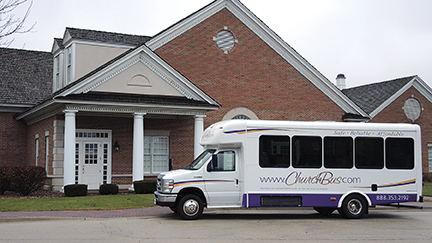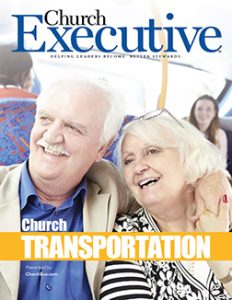5 critical factors — and their impact on your bus ministry
By Mike Jones
![]() Good bus drivers avoid potholes, speedbumps and potentially dangerous conditions on the road.
Good bus drivers avoid potholes, speedbumps and potentially dangerous conditions on the road.
Church leaders should be just as vigilant about heeding potentially dangerous conditions — for themselves and their precious cargo.
Factor #1: The number of buses your church operates
Simply put, the more buses a church runs, the more time and energy it will need to spend on maintenance. Consequently, there’s a greater chance that maintenance on a particular bus will be missed.
Be sure to use a qualified shop or dealership — with trained and certified techs on staff — to maintain your buses. Making sure fluids are changed regularly, that tire tread is in good condition, and that the bus is kept clean and ready to go will head off any problems that might arise due to neglect.
Another safety concern related to multiple church buses is the possibility of drivers being less than qualified to operate the vehicles. With several buses in use, the church needs plenty of drivers at the ready. To meet the demand, it could get slack on drivers’ qualifications.

Factor #2: CDL credentials
In most states, a CDL is not required to operate vehicles with 15 or fewer passengers (including the driver). While this makes a strong case for buses this size, it doesn’t mean drivers shouldn’t have some training on these vehicles. Quite the contrary, in fact.
To be on the safe side, some churches require all drivers to have CDL licenses, regardless of vehicle size. While this makes it much tougher to find drivers, several training programs are available.
If your bus carries 15 passengers or more, it’s against the law for anyone without a commercial driver’s license, or CDL, to operate it. No getting around it.
(NOTE: Some insurance companies have specific requirements for your drivers. Be sure to contact your provider to make sure your bases are covered.)
Factor #3: a mixed fleet
Operating a variety of church vehicles (buses, vans, cutaways, small buses, large buses) can have an effect on driver safety. This is especially true in the case of vans.
For many churches, the “V word” sends up a red flag — and for good reason: vans have been proven to be less safe than buses. While some manufacturers have tried to improve van safety by removing the rear row, a clear relationship exists between a 15-passenger van’s load and its probability of being involved in a rollover accident.

According to GuideOne Insurance, if a van has fewer than 10 passengers, it faces a 12.7-percent chance of a rollover. With 10-plus passengers, that probability rises to 35.4 percent. With 16 passengers and beyond, the insurer estimates a 70-percent chance of a rollover! With these figures in mind, buses emerge as a safer option for church use.
Assuming all the buses are maintained and licensed drivers are used, operating a mix of small and large buses shouldn’t affect overall safety. What does, however, is parents and parishioners driving their own vans or cars for church outings. This practice brings about numerous safety and insurance / liability issues.
Factor #4: driver training
According to National Highway Traffic Safety Administration (NHTSA), driver error is a factor in 93 percent of vehicle crashes. Driver training is a step in the right direction.
The most common approach — and a great place to start — is to follow the Federal and state guidelines for driver training requirements.
Additionally, consider running background checks on drivers. When screening applicants, it’s best to check criminal records, driving records, and the sex offender registry.
Many churches come up with their own training classes to make sure drivers are familiar with bus operation. This often involves getting drivers comfortable navigating the vehicle around town before they take congregants on the road.
Keep in mind that many insurance companies have a list of training and operating requirements. Contact yours for recommendations.
Factor #5: volunteer (vs. staff) drivers
Churches of all sizes find themselves in very different positions regarding staff versus parishioner drivers. It’s completely possible that your most gifted drivers are staff members. It’s equally possible they’re church members.
Regardless, you put your congregation in good hands when you select drivers who’ve demonstrated an overall respect for safety, a clear driving history, and a love for the people they drive.
Carefully consider drivers’ age and experience level. Insurance Institute for Highway Safety shows that drivers under 30 and over 69 are involved in more vehicle crashes than other age groups.
Drivers should also do a road test. Your ministry’s vehicles might handle differently than the ones applicants have driven in the past.
And remember: whoever drives your bus will need to be on your church’s insurance policy! Generally, providers require a driver’s name and a copy of his or her driver’s license.
Finally, when transporting children and teenagers, it’s always a good idea to have more adults onboard than just the bus driver. Crowd control can be a safety factor in these situations.
Mike Jones is National Sales Manager at ChurchBus.com.


